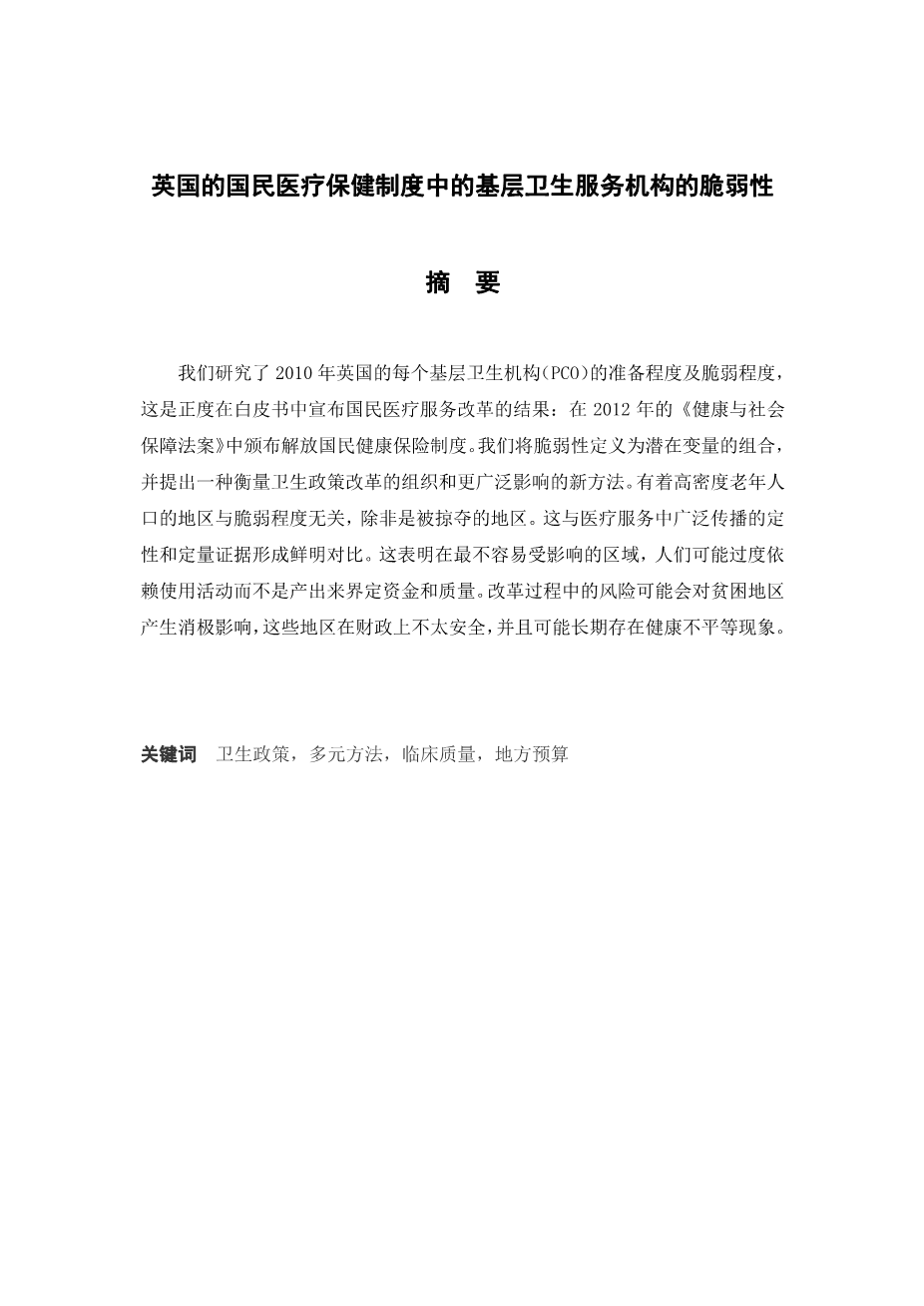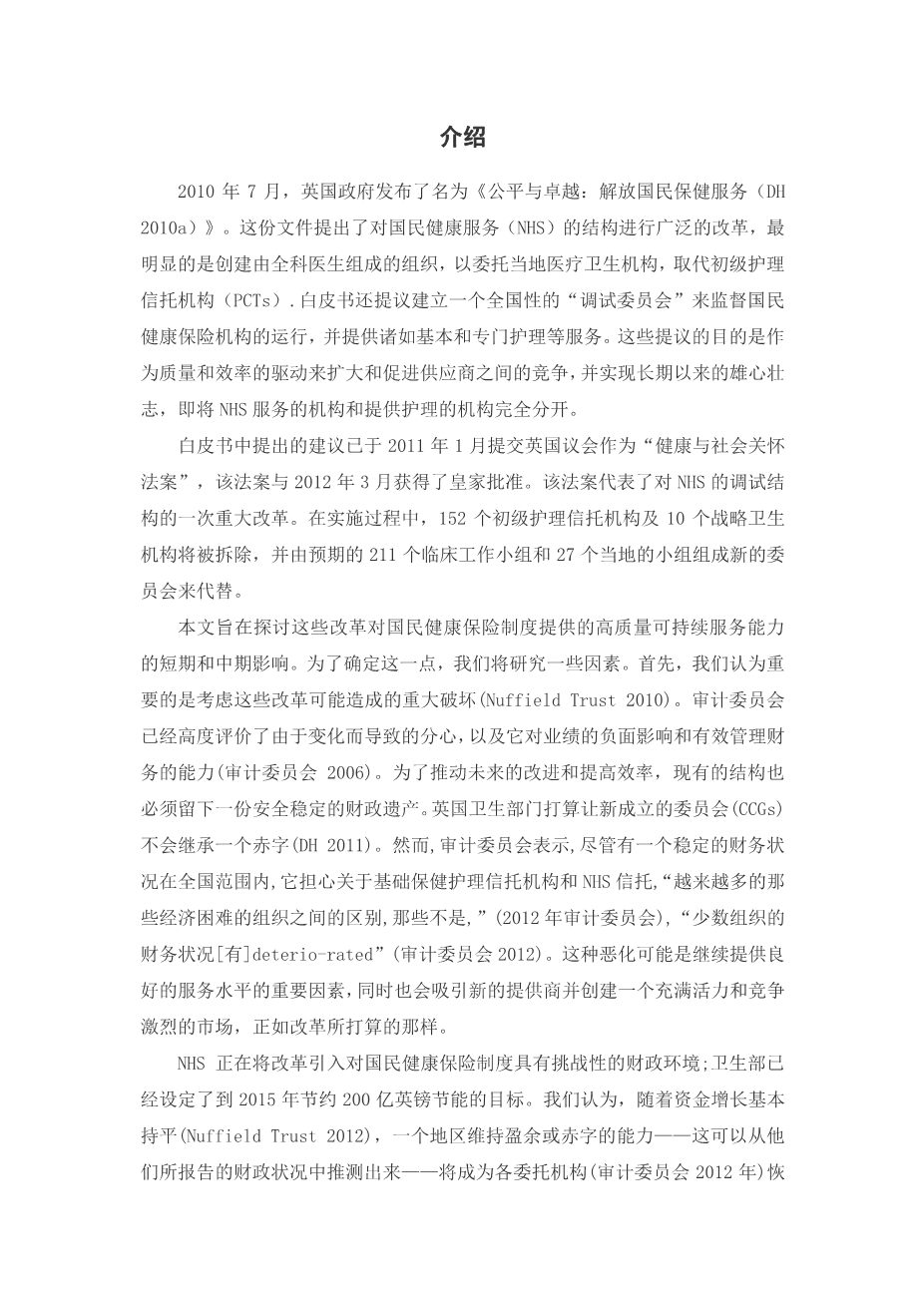Vulnerability of Primary Care Organizations to the National Health Service Reform in England
Jose´ Iparraguirre*, Tom Gentry, and Diego Pen˜a
Jose´ Iparraguirre is the Chief Economist, Tom Gentry is a health policy advisor, and Diego Pen˜a is an intern research assistant, all at Age UK.
*Correspondence may be sent to: jose.iparraguirre@ageuk.org.uk.
Submitted 16 July 2012; revised 5 June 2013; accepted 18 June 2013.
Abstract We study how ready or vulnerable each Primary Care Organization (PCO) in England was in 2010 to the National Health Service reforms announced in the Government white paper Equity and Excellence: Liberating the NHS, later enacted by the Health and Social Care Act 2012. We define vulnerability as a combi-nation of latent variables and present a novel methodological approach to measuring organizational and wider impacts of health policy reforms. Areas with higher con-centrations of older people were not correlated with vulnerability except where there was also deprivation. This contrasts with wide-spread qualitative and quantitative evidence of sub-optimal care of older people within the health service. This suggests there may be an over-reliance on using activity, which was proportionately higher in the least vulnerable areas, to determine funding and quality markers rather than outcomes. A risk of the reform process could be a negative impact on deprived areas which appear to be financially less secure and more likely to have long-established health inequalities.
Key words: Health policy, Multivariate methods, Clinical quality, Local budgets.
JEL Codes: C3, H75, I18.
Introduction
In July 2010, the U.K. Government published the white paper titled Equity and Excellence: Liberating the NHS (DH 2010a). This paper proposed wide-ranging changes to the structure of the National Health Service (NHS) most notably the creation of organizations comprising groups of general practitioners’ (GP) practices to commission local health services, replacing Primary Care Trusts (PCTs).1 The white paper further proposed a national “commissioning board” to oversee the running of the NHS and to
1The NHS refers indistinctly to PCTs and PCOs—primary care organizations—although the former comprise all PCTs and six care trusts. There are 151 primary care organizations (PCOs), of which 145 are PCOs and 6 are care trusts. The PCO is the most common way to refer to all of these; hence we use “PCO” throughout this paper.
- The Author(s) 2013. Published by Oxford University Press, on behalf of Agricultural and Applied Economics Association. All rights reserved. For permissions, please email: journals.permissions@oup.com.
Downloaded from http://aepp.oxfordjournals.org/ at Pennsylvania State University on September 16, 2016 |
1
Applied Economic Perspectives and Policy
commission services such as primary and specialized care. Underpinning these proposals was the intention to expand and promote competition between providers as a driver of quality and efficiency, and to implement a long-standing ambition to fully separate the bodies commissioning NHS services and those providing care (Turner and Powell 2011; Porter et al. 2013).
The proposals outlined in the white paper were tabled in the U.K. Parliament as the Health and Social Care Bill in January 2011, which received Royal assent in March 2012. The Act represents a major overhaul of the commissioning structure of the NHS (Kmietowicz 2012). In the process of their implementation, the 152 PCTs and 10 Strategic Health Authorities (SHAs) will be dismantled and replaced by an expected 211 clinical com-missioning groups and the new NHS Commissioning Board, which will have 27 Local Area Teams (LATs).
This paper seeks to explore the short- to medium-term impact of these reforms on the ability of the NHS to deliver high quality, sustainable serv-ices. To determine this we will examine a number of factors. Firstly, we believe it is important to consider the significant disruption these reforms are likely to cause (Nuffield Trust 2010). The Audit Commission has high-lighted the distraction caused by periods of change, as well as its negative impact on performance and the ability to effectively manage finances (Audit Commission 2006). It is also imperative for the existing structure to leave a secure and stable fiscal legacy in order to drive future improvements and efficiencies. The U.K. Department of Health intends that the new com-missioning organizations (CCGs) will not inherit a deficit (DH 2011). However, the Audit Commission has said that while there was a stable financial position nationally, it has concerns that with regard to PCTs and NHS trusts, “there is a growing difference between those organizations that are struggling financially and those that are not,” (Audit Commission 2012) and that “the financial position of a minority of organizations [had] deterio-rated,” (Audit Commission 2012). This deterioration could be an important factor in continuing to provide a decent level of service, as well as attracting new providers and creating a vibrant and competitive market as the reforms intend.
The reforms are being introduced into a challenging financial environ-ment for the NHS; the Department of Health has set a target of £20 billion of efficiency savings by 2015 (DH 2009). With funding growth essentially flat (Nuffield Trust 2012), the ability of an area to maintain a surplus or deficit— which can be surmised
剩余内容已隐藏,支付完成后下载完整资料


英语译文共 13 页,剩余内容已隐藏,支付完成后下载完整资料
资料编号:[469309],资料为PDF文档或Word文档,PDF文档可免费转换为Word


